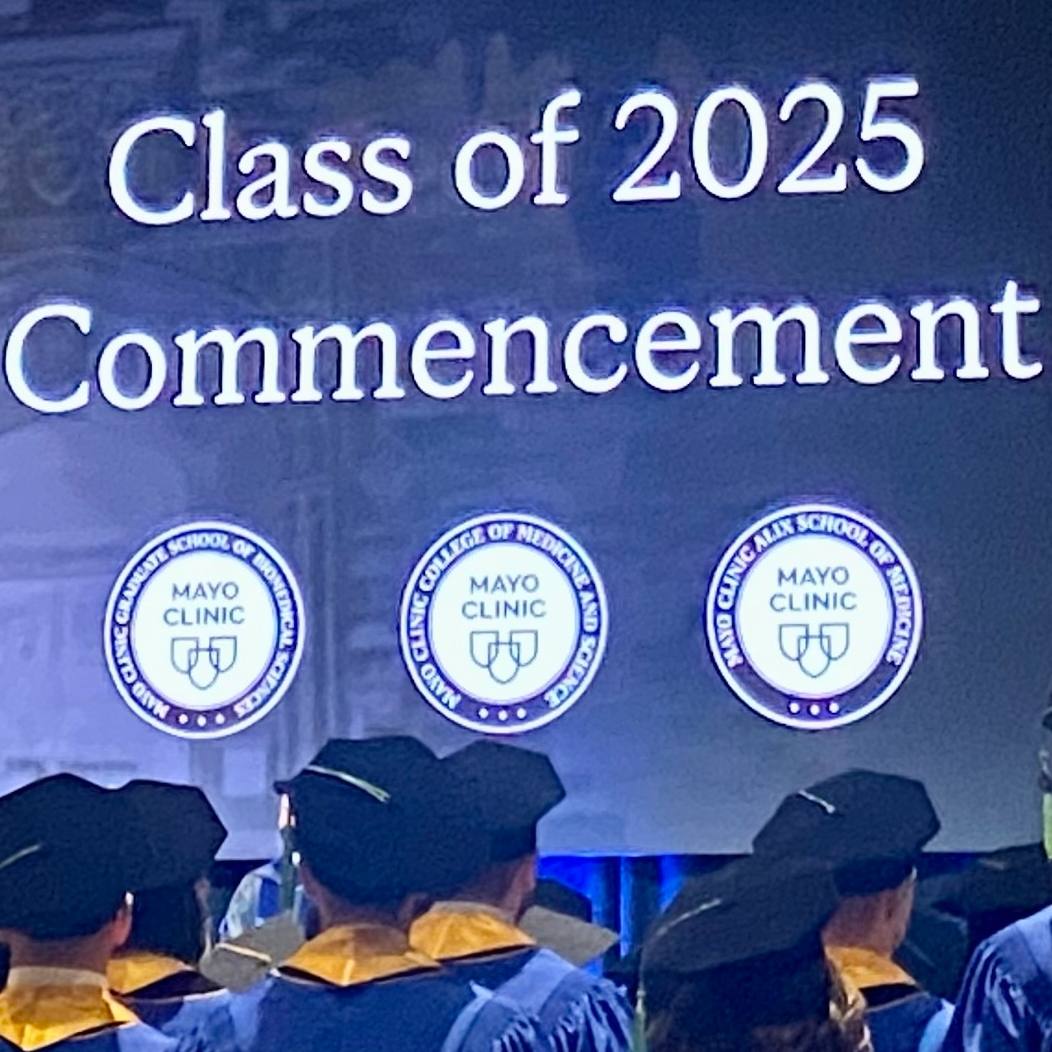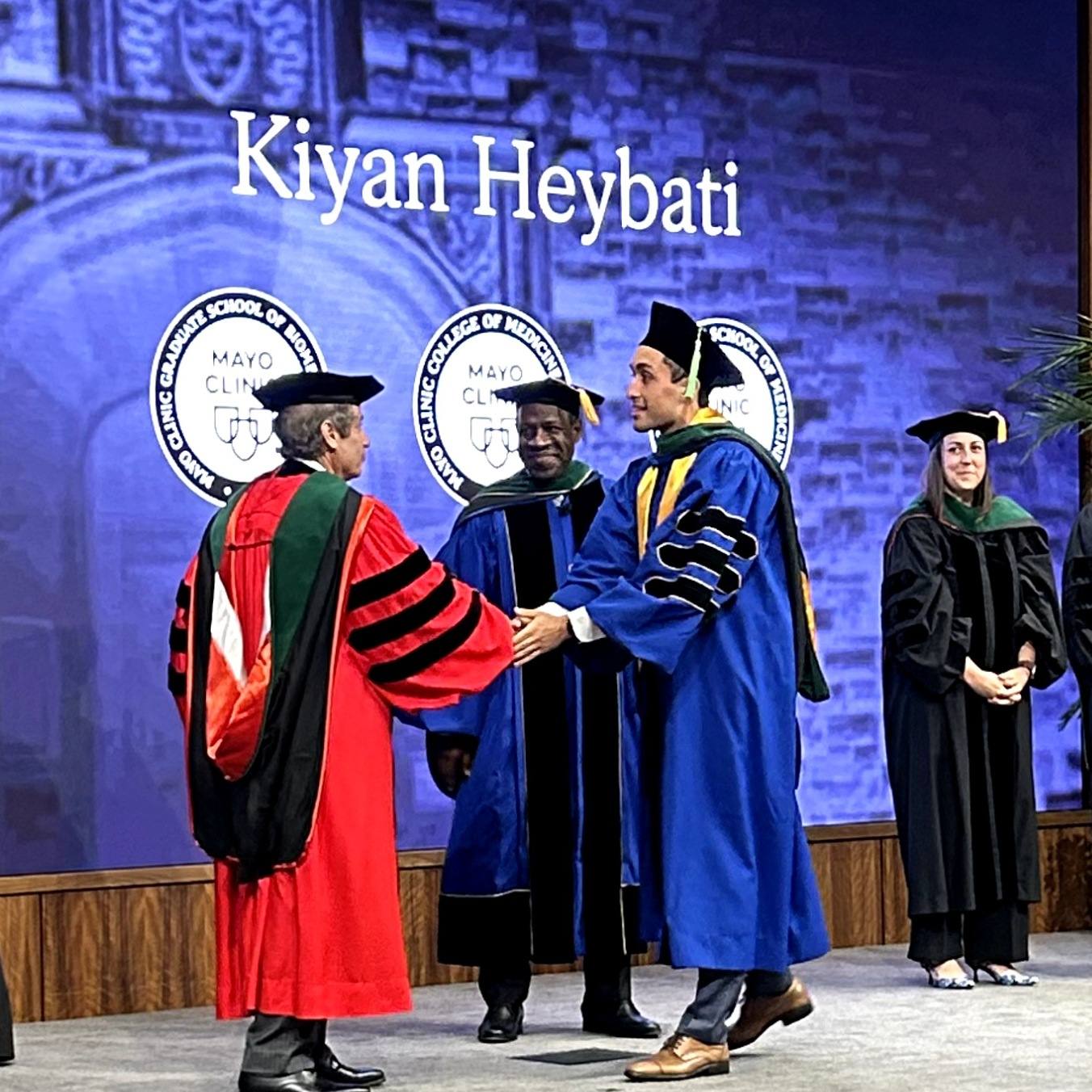-
Science Saturday: Mayo innovation, research at forefront of World War II victory
If you watched "Top Gun: Maverick" this summer, you saw a fictional portrayal of how fighter pilots can perform incredible aerial maneuvers at high G-forces, or the force of gravity. Here's the story about the role Mayo Clinic had in enabling pilots to reach those heights and possibly win a war.
In 1942, as members of their community joined the service or started jobs supporting the military, the U.S. government secretly tasked a small group of Mayo Clinic physicians and researchers to develop technology that would help lead the U.S. and its Allies to victory a few years later.
Mayo Clinic physician-researchers Walter Boothby, M.D.; W. Randolph Lovelace II, M.D.; and Arthur Bulbulian, D.D.S., had successfully designed an oxygen mask, called the BLB mask (for Boothby-Lovelace-Bulbulian), a few years earlier to solve the problem of airplane passengers experiencing low oxygen levels while flying. Now adjustments were needed to better suit military needs for the war effort.
Dr. Bulbulian quickly got to work improving the mask for pilots who were flying jets higher and faster than typical aircraft. The updated BLB mask, now known as the A-14 mask, provided pilots with as much supplemental oxygen as needed, was frost-resistant, had a microphone for radio communications and allowed pilots to talk with the mask on.

The First 'Mayo-1'
As Dr. Bulbulian solved one problem, the U.S. military quickly discovered another. The pilots would experience G-forces so severe that it would result in blackouts. At 2-Gs, pilots feel twice their body weight pushing them against their seats. At 3-Gs, they experience triple their weight and so on. As the G-force increases, it becomes increasingly difficult for the heart to pump blood to the head, resulting in a lack of oxygen to the brain. To discover how pilots tried to combat this on their own, researchers went right to the source.
"Pilots would consistently say that they would just yell at the top of their lungs as they were about to pull out of their bomb-diving run," says Jan Stepanek, M.D., director of Aerospace Medicine at Mayo Clinic in Arizona.
"When you really yell hard, you create increased pressure in your chest, which results in high blood pressure as long as you're yelling," Dr. Stepanek says.
The goal of Mayo Clinic researchers Earl Wood M.D., Ph.D., and Charlie Code, M.D., was to find a practical way to keep blood flowing to the brain during gravitational stress because pilots could only yell for so long. This led to the development of the M-1, or Mayo-1, maneuver. This eventually developed into what is known today as the anti-G straining maneuver, nicknamed "the grunt."
"What it is is a straining maneuver that is designed to primarily increase arterial blood pressure. It consists of voluntary contractions of both legs, calves, thighs, arms and increasing pressure in your abdomen," Dr. Wood said in an interview for the Mayo Heritage film, "Reaching New Heights: Secret Stories of the Mayo Clinic Aero Medical Unit." "When someone knows how to do that, they can increase their blood pressure … if they work at it hard enough."
This maneuver had pilots focus on constricting their bodies and controlling their breathing in such a way that blood could flow more easily to their hearts and brains so they wouldn't suffer loss of consciousness while experiencing higher G-forces. However, the anti-G straining maneuver alone couldn't get them to safely fly over 3- and 4-Gs.
Still the anti-G straining maneuver is incredibly important for pilots even now.
"The maneuver was teachable and trainable, and arguably more important than the G-suit," says Dr. Stepanek.

Introducing the New and Improved G-suit
While the original model of the G-suit had already been developed, improvements made by Dr. Wood, and David Clark, a weaver from Massachusetts, is what allowed pilots to fly up to a force of 9-Gs. Dr. Wood and Clark took the revolutionary concept of the G-suit, developed in 1941 by a team led by Wilbur Franks, M.D., at the University of Toronto, and devised an inflatable, five-bladder system that could be slipped into a garment. At the same time, the aeromedical team perfected a valve to reliably connect the suit to the plane's air pressure system. While the previous design focused more on the gravitational pull, Dr. Wood's design focused on increasing arterial pressure without needing the pilot's attention or effort.
Testing the suit's design, however, wasn't an easy task. Researchers and physicians didn't want to test the concept on anyone, as the effects G-forces cause — lack of oxygen to the brain and blood flow to the heart — weren't yet known. So, they tested it on themselves.
The need for testing G-suit designs led Mayo Clinic researchers to build a gigantic human centrifuge in the Medical Sciences Building in Rochester. The centrifuge, designed and built by Dr. Code; E.J. Baldes, M.D.; and Adrien Porter, was the first of its kind in the U.S. A simulated cockpit was attached to the end of a tubular steel structure powered by the remains of a wrecked Chrysler automobile engine. Two 20-ton flywheels provided the momentum and energy to spin the cockpit at high speeds, creating intense G-forces. Using the centrifuge, the Mayo Aeromedical Unit gathered the most complete data ever recorded on the effects of G-forces.

When asked about the unknown damage lack of oxygen causes to the brain, Dr. Wood said in the film he didn't really think about it. "I don't remember having any concern that the repeated blackouts and so on might cause residual damage. We never worried about it very much."
Even with the data, pilots wanted real-world proof that the suits would work before trusting their lives to the new technology. This led the Mayo Clinic Aeromedical team to request a fighter plane — a Douglas Dauntless dive bomber — and a volunteer pilot.
To test the inventions themselves, the pilot would fly the plane while the researchers sat in the back seat. These real-world experiments, led by Edward Lambert, M.D., Ph.D., proved that the G-suit alone could provide protection up to 7-Gs.
When the suit was combined with the use of the anti-G straining maneuver, pilots could still function up to forces of 9-Gs. After this testing, the concept of the new G-suit was accepted by the Army and Navy and is sometimes credited as making a difference in winning World War II.
According to a 2009 article in The Wall Street Journal, after seeing a G-suit on a downed American pilot, Wilhelm Messerschmitt, Germany's leading designer of fighter planes, said, "We had nothing to match it, and I knew if American aviation science was so far ahead of us to make such a suit, Germany had lost the war already."
Today, the G-suit concept and anti-G straining maneuver created by the team at Mayo Clinic is used by fighter pilots worldwide.

Other Medical Discoveries
While the G-suit is no doubt an incredible feat, its invention — and those leading up to it — led to several other medical discoveries. Without the BLB oxygen mask, oxygen tents might still be used inside hospitals. Techniques for measuring data on the human centrifuge contributed to cardiac catheterization. And the G-suit led to the invention of the finger pulse oximeter as a way to measure the blood's oxygen level.
Military Medicine Education
"The Mayo brothers actually had military medical courses," says Dr. Stepanek. "Countless trainees came through Mayo Clinic to learn from the likes of Drs. Boothby, Loveless and Wood to be trained about the effects of altitude, hypoxia, how to protect yourself and how to actually create life support systems and procedures to avoid getting into any challenges or problems."
Military medicine education continues to thrive within Mayo Clinic today. "Mayo Clinic Military Medicine is an enterprisewide organization with a primary focus on education," says Amy Low, operations manager for the Center for Military Medicine. "Military Medicine provides cutting-edge medical courses to military and select government agencies with Mayo Clinic educators from various specialties. We are proud to host two military education fellows and partner with the Army-Baylor Fellowship Program at Mayo Clinic."
To find out more about how Mayo Clinic has been involved in the history of the U.S. military, visit Mayo Clinic History & Heritage website and the Department of Defense Medical Research Office webpage.







